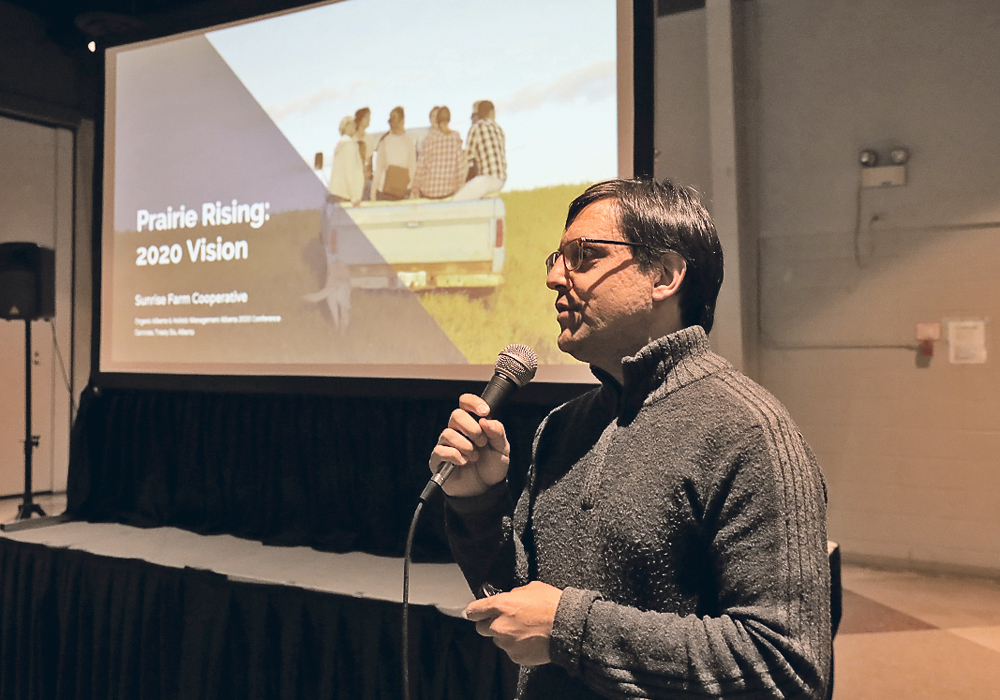The Sunrise Community Farm Co-op wants to buy an Alberta farm as part of an effort to maintain its rural sustainability
CAMROSE, Alta. — Twenty years ago Don and Marie Ruzicka changed the way they farmed. Now they hope they can create a new way to sell the farm.
Their 640-acre certified organic Ruzicka Sunrise Farm has become an ecological oasis with native prairie, replanted tame pasture, large bodies of water protected by vegetation, more than 100,000 planted trees, 200 birdhouses placed around the farm and almost 100 bird species as part of their farming operation.
It has also become a destination and retreat for students, professors and urban people who want to learn more about agriculture and rural Alberta.
Read Also

Agritechnica Day 2: The future of tractor power, building quicker crop apps and large farms and tech
Agritechnica Day 2: The future of tractor power, building quicker crop apps with Syngenta and large farms and tech
But how do you sell such a specialized farm when you want to retire?
Rajan Rathnavalu hopes a proposed co-op, Sunrise Community Farm, will raise enough money to buy the farm and become a template for other farm sales and to rebuild communities across the Prairies.
Rathnavalu’s grandfather moved from Scotland to Canada like thousands of other settlers for the promise of a better life. Posters from the Canadian government in the 1920s promoted a vision of prosperity, family and community on the Prairies. As the son of a Scottish game farmer, his grandfather knew he would never have the opportunity to own land. The Prairies held promise for Rathnavalu’s family. Here, you could own land and have a future.
“The prairie promise built towns and communities.”
But as farms get bigger, towns get smaller and farmers get older, how do you attract young people to the farm like the early settlers?
If the Sunrise Community Farm Co-op is a success, Rathnavalu hopes it may become a template for farm transfers, attracting young people back to the farm and rebuilding rural towns.
“We’re excited about this,” said Don Ruzicka, who knows it won’t be easy to find investors interested in developing a new model for rural sustainability rather than return on investment.
“There is a lot of potential in carrying on what’s here.”
Since switching from conventional agriculture in the 1990s to a holistic management approach to agriculture and becoming a certified organic farm, the Ruzicka’s have made a living on their Viking-area farm raising pasture-raised poultry, beef and pork, custom grazing, teaching and hosting visitors.
“It’s become a model for regenerative agriculture on the Prairies. It’s a real jewel,” said Rathnavalu.
“Who has $2 million to buy a section of land? We need a new model for transition. If you’re burdened with debt, you have to drain the wetlands, or think you do.”
A group of enthusiasts meet every week to finalize the formation of the co-op. They were given a partially formed co-op structure, the Wavy Lake Opportunity Development Co-operative, initiated to build an abattoir, which never got off the ground. Once the details of this co-op are finalized, they will spend four to six months to raise $2 million to buy the Ruzicka farm.
Treva Olson of Camrose is part of the group working to make the co-op a reality. She was introduced to the farm through the Spirit of the Land program at the University of Alberta’s Augustana campus. Through the program she met young people and learned about agriculture.
“I realize these two go hand in hand. I realize the value of retaining sacred land and spaces.”
June Osborne of Camrose wasn’t born on the Prairies, but she has fallen in love with the region and agriculture and wants more people to learn about farming.
“Through meeting people, they taught me about being stewards of the land and the deep-rooted commitment to the land.”
Osborne said people in urban areas who believe in biodiversity, carbon sequestration and water protection need to join the conversation and become investors.
“I discovered people across North American are absolutely passionate about saving native prairie and restoring what is here. It needs to come into the conversation of the general population.”
Olson said finalizing the co-op and raising money will not be easy.
“Raising $2 million is not going to be easy-peasy. We’re out educating. If it happens, it will be part miracle. We all have a positive view. One step at a time and we will make it.”
Rathnavalu said the project is more than raising money and buying one farm. It needs to be a template for other farms sales to sustain rural communities.
“I’d hate to be a postage stamp farm in a sea of big ag.”















